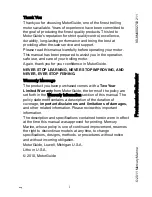
MAINBOARD BIOS SETUP
MAINBOARD BIOS SETUP
P5V30-B4 User’s Manual
P5V30-B4 User’s Manual
16
16
About the BIOS
The
Mainboard BIOS
(Basic Input/Output System) acts as the bridge between your
Hardware
(CPU, Disk Drives, Video, etc.) and Operating System
Software
(Windows 95,
OS/2 and so on…) The BIOS Setup (also called CMOS Setup) is where many hardware
configuration options are set and stored. This configuration information will remain in the
BIOS until it is changed, or cleared via the “Clear CMOS” jumper (see page 11).
CMOS (Complementary Metal Oxide Semiconductor) refers to the chip in which the BIOS
information is stored.
The P5V30-B4 mainboard features
Award BIOS
, which provides an easy to use Setup
program to aid in hardware configuration. In this section we will look at the various menus
and options contained in the Award BIOS Setup Program. This mainboard also features a
“Flash” BIOS. A Flash BIOS can be upgraded via software, thereby eliminating the need to
actually replace the “BIOS Chip” on the mainboard. Procedures for updating the BIOS
follow this section.
The Award BIOS installed in your computer system’s ROM (Read Only Memory) is a
custom version of an industry standard BIOS. This means that it supports Intel/Cyrix/AMD
processors in a standard IBM-AT compatible input/output system.
Using Setup
In general, you use the arrow keys to highlight items, press <Enter> to select, use the
PageUp and PageDown keys to change entries, press <F1> for help and press <Esc> to quit.
Getting Help
Pressing F1 will display a small help window that describes the appropriate keys to use and
the possible selections for the highlighted item. To exit the Help Window press <Esc>.
A Final Note About Setup
Not all systems have the same Setup. While the basic look and function of the Setup
program remains the same for all systems, individual motherboard and chipset combinations
require custom configurations. For example, you may find that your Setup main menu has a
different number of entries from the main menu displayed in this manual. These are simply
features not supported (or not user configurable) on your system.
The final appearance of the Setup program also depends on the Original Equipment
Manufacturer (OEM) who built your system. If your OEM has decided that certain items
should only be available to their technicians, those items may very well be removed from
the Setup program.














































